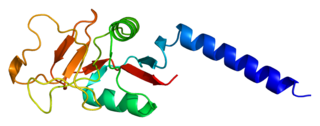Related Research Articles

Hashimoto's thyroiditis, also known as chronic lymphocytic thyroiditis and Hashimoto's disease, is an autoimmune disease in which the thyroid gland is gradually destroyed. Early on, symptoms may not be noticed. Over time, the thyroid may enlarge, forming a painless goiter. Some people eventually develop hypothyroidism with accompanying weight gain, fatigue, constipation, depression, hair loss, and general pains. After many years the thyroid typically shrinks in size. Potential complications include thyroid lymphoma.

Gene–environment interaction is when two different genotypes respond to environmental variation in different ways. A norm of reaction is a graph that shows the relationship between genes and environmental factors when phenotypic differences are continuous. They can help illustrate GxE interactions. When the norm of reaction is not parallel, as shown in the figure below, there is a gene by environment interaction. This indicates that each genotype responds to environmental variation in a different way. Environmental variation can be physical, chemical, biological, behavior patterns or life events.

Mannose-binding lectin (MBL), also called mannan-binding lectin or mannan-binding protein (MBP), is a lectin that is instrumental in innate immunity as an opsonin and via the lectin pathway.
Public health genomics is the use of genomics information to benefit public health. This is visualized as more effective preventive care and disease treatments with better specificity, tailored to the genetic makeup of each patient. According to the Centers for Disease Control and Prevention (U.S.), Public Health genomics is an emerging field of study that assesses the impact of genes and their interaction with behavior, diet and the environment on the population's health.

Prostaglandin-I synthase also known as prostaglandin I2 (prostacyclin) synthase (PTGIS) or CYP8A1 is an enzyme involved in prostanoid biosynthesis that in humans is encoded by the PTGIS gene. This enzyme belongs to the family of cytochrome P450 isomerases.

Caspase 12 is a protein that in humans is encoded by the CASP12 gene. The protein belongs to a family of enzymes called caspases which cleave their substrates at C-terminal aspartic acid residues. It is closely related to caspase 1 and other members of the caspase family, known as inflammatory caspases, which process and activate inflammatory cytokines such as interleukin 1 and interleukin 18.
HLA-DQ1 is a serotype that covers a broad range of HLA-DQ haplotypes. Historically it was identified as a DR-like alpha chain called DC1; later, it was among 3 types DQw1, DQw2 and DQw3. Of these three serotyping specificities only DQw1 recognized DQ alpha chain. The serotype is positive in individuals who bear the DQA1*01 alleles. The most frequently found within this group are: DQA1*0101, *0102, *0103, and *0104. In the illustration on the right, DQ1 serotyping antibodies recognizes the DQ α (magenta), where antibodies to DQA1* gene products bind variable regions close to the peptide binding pocket.
An immune disorder is a dysfunction of the immune system. These disorders can be characterized in several different ways:

The neuropeptide S receptor (NPSR) is a member of the G-protein coupled receptor superfamily of integral membrane proteins which binds neuropeptide S (NPS). It was formerly an orphan receptor, GPR154, until the discovery of neuropeptide S as the endogenous ligand. Increased expression of this gene in ciliated cells of the respiratory epithelium and in bronchial smooth muscle cells is associated with asthma. This gene is a member of the G protein-coupled receptor 1 family and encodes a plasma membrane protein. Mutations in this gene have also been associated with this disease.

Natural resistance-associated macrophage protein 1 is a protein that in humans is encoded by the SLC11A1 gene.

Parkin coregulated gene protein is a protein that in humans is encoded by the PACRG gene.

Transcription regulator protein BACH2 is a protein that in humans is encoded by the BACH2 gene. It contains a BTB/POZ domain at its N-terminus which forms a disulphide-linked dimer and a bZip_Maf domain at the C-terminus.

Protocadherin 11 X-linked, also known as PCDH11X, is a protein which in humans is encoded by the PCDH11X gene.

Interleukin-23 receptor is a type I cytokine receptor. IL23R is the name of its human gene.

Interleukin 18 receptor accessory protein, also known as IL18RAP and CDw218b, is a human gene.

HLA-B39 (B39) is an HLA-B serotype. The serotype identifies the more common HLA-B*39 gene products.

Zinc transporter 1 is a protein which in humans is encoded by the SLC30A1 gene.
Interferon gamma receptor 2 also known as IFN-γR2 is a protein which in humans is encoded by the IFNGR2 gene.

Tektin 1 is a protein that in humans is encoded by the TEKT1 gene.

Immunity-related GTPase family M protein (IRGM), also known as interferon-inducible protein 1 (IFI1), is an enzyme that in humans is IRGM gene.
References
- ↑ "Human PubMed Reference:". National Center for Biotechnology Information, U.S. National Library of Medicine.
- ↑ "Entrez Gene: Graves disease, susceptibility to, X-linked" . Retrieved 2016-04-18.